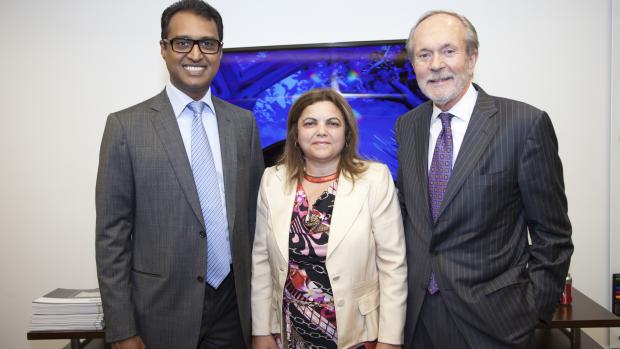Shifting Sublime: Charugundla Collection Opens at NYU-Poly

Thursday night’s opening of “Shifting Sublime,” a contemporary art exhibition at NYU-Poly, began with a toast to alumni Kent and Marguerite Charugundla, who have loaned works from their collection to the school for the next six months.
“We’ll never know all the things that [the Charugundla exhibition] may inspire,” said President Jerry Hultin, raising his glass to the couple.
The exhibition features an eclectic assortment of paintings, prints, animations, and historic Bollywood posters, yet it represents only a fraction of the Charugundlas’ extensive collection. “We’ve been collecting art since the 1990s,” said Marguerite Charugundla. “But what is art without the audience? Art and engineering go together. I hope this will lift [students’] spirits and be an outlet for them.”
The Charugundlas are co-founders of the Tamarind Arts Council, a non-profit that promotes Indian art, and both are graduates of the Management of Technology Executive Master's program (eMOT)—Marguerite in 2010, Kent in 2012. Kent Charugundla chose NYU-Poly for his graduate work two decades after launching a successful career as a telecom entrepreneur. “It was invigorating,” he said of his studies here. “I’m always interested in learning. In the past, I’ve learned from the most experienced people, and now I wanted to learn from the younger people.”
He also praised the team of administrators, faculty, and students who helped to bring this exhibition to fruition from its first seed as an idea raised in a development meeting. Two members of that team were Rupa Shah, the Charugundlas’ curator, and Amy Lei, NYU-Poly’s Senior Development Officer. As guests mingled, Shah and Lei shared a laugh, recalling the challenges of hanging work in the cafeteria and above the library stairs. “The logistics were different from any show that I’ve curated before,” said Shah. “[But] the curatorial process was liberating.”
Later, Shah and Kent Charugundla narrated a tour of works on display, from an M. Sashidharan painting of a man reclining on a bed of nails in the shape of a bar code to a Bollywood poster that goes back to the 1940s. Much of the collection, said Shah, is a commentary on vertical growth, changing Indian society, and the symbiosis of folk art and technology.
“India is undergoing a major transformation, and so is its art,” said Shah.
Stopping before “The Sound of Silence,” a spare, semi-abstract, and amber-hued figural painting by Samir Aich, she pointed out the complexity of the painting’s uncomfortably posed subject.
“It looks like a representation of the pain before finals,” joked alumnus Gordon Cabaniss eMOT’12, eliciting laughs of self-recognition from several members of the tour group.
But administrators hope that some of that pain will be assuaged by the palliative power of art—and replaced by inspiration. “We’re taking care to remind our students to be well-rounded, whole, and interesting people,” said Lei. “Studying is important, but we can balance that with exposure to art.”





